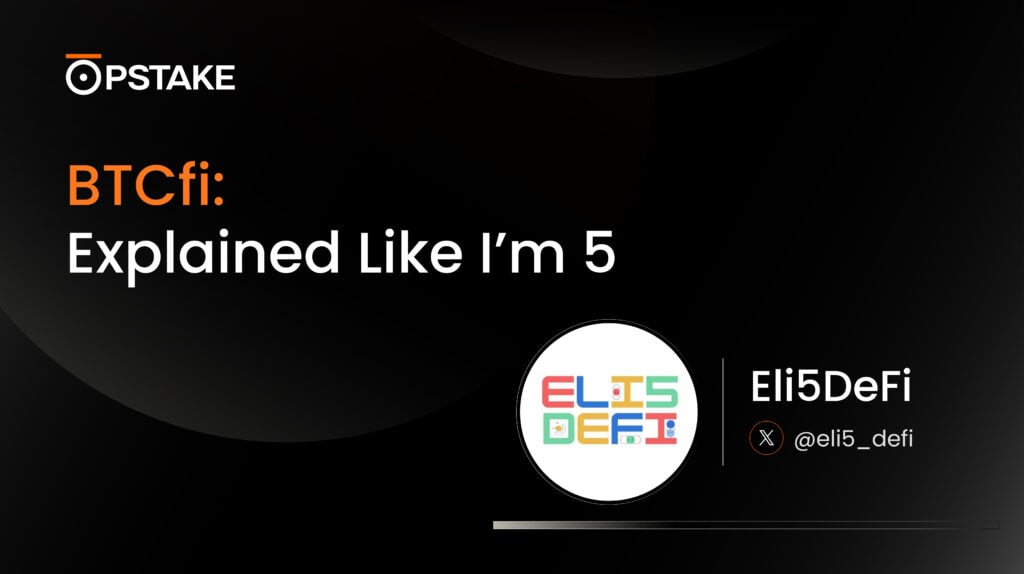The growth of Bitcoin has been truly remarkable.
Bitcoin surged to an incredible $1.5 trillion market cap due to its value proposition of being “Digital Gold,” creating a strong narrative around it as a store of value for the digital internet.
Sentiment surrounding Bitcoin’s value proposition was built on the ‘HODL’ philosophy, a concept of holding an asset for capital appreciation. ‘HODL’ originated from a misspelling of ‘hold’ in a Bitcoin forum post and has since become a popular meme in the cryptocurrency community.
Unfortunately, Bitcoin’s static ‘HODL’ narrative has become a limitation, with many long-term holders realizing that there are no yields beyond capital appreciation, which is seeing lower multiples each cycle.
Introducing yields to Bitcoin would change this dynamic, allowing BTC investors to earn while “HODLing”.
This is where liquid staking can help Bitcoin.
Liquid staking can energize Bitcoin’s value proposition by adding an entirely new layer to earnings through yield generation. This will be a game-changer for Bitcoin, as it could attract more investors who are looking for assets that can generate a passive income, potentially increasing its demand and value.
In this article, we will explore the transformative potential of liquid staking for Bitcoin and highlight its implications for the future direction of the heavyweight digital cryptocurrency. First, take a look into this blog post to learn more about liquid staking, and this one to find out why we’re using Babylon.
Bitcoin’s Original Value Proposition Is Changing
Bitcoin made its mark on the finance industry by being heralded as digital gold.
Initially, the industry believed that Bitcoin would become decentralized cash, but rising transaction fees and slow transaction speeds quickly transformed its value proposition into a store of value asset—similar to gold.
The value of the asset was built on the following three principles:
- Digital Scarcity: Bitcoin introduced the world to a digital wealth limited by a 21 million BTC supply.
- Decentralization: Bitcoin runs on a network maintained by independent participants around the globe that can’t be controlled by governments or institutions
- Security: Bitcoin has a robust security model based on cryptographic principles and mining, which has never been hacked.
Despite these principles, Bitcoin is missing something the industry has yearned for: Yield Generation.
Bitcoin’s lack of yield-generating mechanisms has been increasingly discussed, as other cryptocurrencies offer ways to earn multiple sources of revenue through staking or liquidity provision.
Well, Bitcoin’s value proposition is now seeing a notable shift, and we’re here at the very start of the change.
The narrative behind Bitcoin’s value proposition is shifting away from a store of value into a yield-generating asset through new innovations such as security sharing through Babylon and liquid staking through pSTAKE.
These new innovations help provide more utility for Bitcoin beyond ‘HODLing,’ opening the doors for retail and institutional investors to utilize their BTC assets actively.
Understanding Liquid Staking
Traditional staking from proof-of-stake cryptocurrencies requires users to lock their tokens into the protocol to add security and earn rewards. Unfortunately, when staked, holders relinquish asset liquidity as it remains locked in the protocol.
Liquid Staking is a concept that allows holders of cryptocurrencies to stake their assets, add security to a network, and earn rewards while retaining their assets’ liquidity.
In a nutshell, liquid staking elevates the staking process and takes it one step further. Users receive a liquid staking derivative that typically reflects the value of the staked asset, allowing it to be used elsewhere in DeFi protocols to generate more yield.
Unfortunately, liquid staking has only been available to proof-of-stake networks, and Bitcoin’s proof-of-work network hasn’t been able to take advantage of it…until now.
Newly emerging innovations from Babylon and pSTAKE are bringing liquid staking to Bitcoin, allowing BTC holders to earn a native yield on their assets. Here’s how it works:
- Stake Your Bitcoin: Users lock their Bitcoin into the pSTAKE protocol to start the staking process.
- Receive a Liquid Staking Token: Once deposited, pSTAKE will mint a liquid staking token to represent the staked asset.
- Earn Yields: pSTAKE deposits the staked assets onto the Babylon Bitcoin security-sharing infrastructure, generating PoS token yields for BTC holders through staking rewards on PoS chains consuming the shared-security from Babylon.
- Retain Liquidity: Holders of the liquid staked BTC can continue using it as a standard asset, utilizing it elsewhere in DeFi protocols that accept the asset.
pSTAKE Finance makes staking BTC incredibly easy while maintaining the trust BTC holders require through Babylon’s native staking architecture, which doesn’t require bridging or relinquishing custody.
Introducing liquid staking to Bitcoin will profoundly affect the Bitcoin market, generating new interest and helping long-term holders earn a secure yield.
Impact on Bitcoin Holders and Market
Liquid staking is about to change Bitcoin’s value proposition in a big way. The mechanism allows holders to utilize their BTC to generate yield while retaining the token’s liquidity.
For example, liquid staking will give Bitcoin a new utilitarian dimension, turning it from a store of value into an asset that generates passive income.
The additional utility will change the HODL narrative into an ‘earn’ narrative as BTC holders explore potential yield-generating opportunities.
Introducing yield to the equation will also incentivize a new wave of BTC holders who are actively looking for an appreciating asset that generates yield.
In addition to the increased participation, generating yield for holders will also dramatically change investor behavior, which could help bring price stability. Yield generation typically results in reduced volatility over time, which could be a significant benefit for Bitcoin, as it could attract more risk-averse investors who are deterred by its current high volatility.
Finally, the introduction of yield to Bitcoin will not only provide more opportunities for all retail holders but also open the doors for heavyweight institutions. This could convince them to continue pouring trillions of dollars into Bitcoin through the ETFs, as they can become capital efficient by generating yield.
Conclusion: A New Yield Generation Chapter Awaits
The introduction of liquid staking to Bitcoin could mark a new era for the original cryptocurrency, transforming it from a passive store of value to an active, yield-generating asset. This evolution could enhance Bitcoin’s appeal, broaden its user base, and help it integrate more deeply into the burgeoning DeFi ecosystem. The transformative potential of liquid staking is something that every Bitcoin enthusiast should be eager to explore.
The path to implementing liquid staking must be navigated carefully, balancing innovation with security and decentralization – which is why pSTAKE is already taking on this challenge. Follow our social media channels to join the discussion and stay up to date on the moment BTC liquid staking goes live on pSTAKE.
Overall, Bitcoin’s journey is far from over and is now entering a new, exciting chapter.










